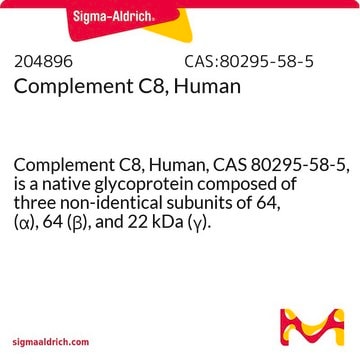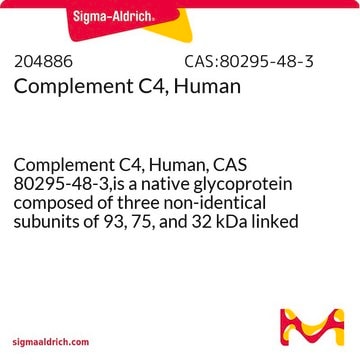204897
Complement C4b, Human
Complement C4b, Human, is a native, 193 kDa glycoprotein composed of the modified C4 α-chain (α′) and intact β- and γ-chains complement component.
Zaloguj sięWyświetlanie cen organizacyjnych i kontraktowych
About This Item
Kod UNSPSC:
12352202
NACRES:
NA.25
Polecane produkty
Poziom jakości
Próba
≥95% (SDS-PAGE)
Postać
liquid
nie zawiera
preservative
producent / nazwa handlowa
Calbiochem®
warunki przechowywania
OK to freeze
avoid repeated freeze/thaw cycles
zanieczyszczenia
IgG, IgA, IgM, Factor B, Factor H, C3, ceruloplasmin, or albumin, trace
Warunki transportu
wet ice
temp. przechowywania
−70°C
Działania biochem./fizjol.
Complement C4b fragment is formed by the cleavage of the C4 α-chain by activated C1 enzyme. Like C3b, C4b has the transient ability to form a covalent ester bond with a variety of target cell surfaces. Target surface-bound C4b acts as an important non-enzymatic subunit of the classical pathway C3 cleaving enzyme (C4b, C2a). This surface-bound C4b also exhibits opsonic and immune adherence activities which are dependent on the CR1 (CD35) complement receptor found on many inflammatory cells.
ComplementC4b fragment is formed by the cleavage of the C4 α-chain by activated C1enzyme. Like C3b, C4b has the transient ability to form a covalent ester bond with a variety of target cell surfaces. Target surface-bound C4b acts as an important non-enzymatic subunit of the classical pathway C3 cleaving enzyme (C4b, C2a). This surface-bound C4b also exhibits opsonic and immune adherence activities which are dependent on the CR1 (CD35) complement receptor found on many inflammatory cells.
Opakowanie
Please refer to vial label for lot-specific concentration.
Ostrzeżenie
Toxicity: Standard Handling (A)
Informacje prawne
CALBIOCHEM is a registered trademark of Merck KGaA, Darmstadt, Germany
Kod klasy składowania
12 - Non Combustible Liquids
Klasa zagrożenia wodnego (WGK)
nwg
Temperatura zapłonu (°F)
Not applicable
Temperatura zapłonu (°C)
Not applicable
Certyfikaty analizy (CoA)
Poszukaj Certyfikaty analizy (CoA), wpisując numer partii/serii produktów. Numery serii i partii można znaleźć na etykiecie produktu po słowach „seria” lub „partia”.
Masz już ten produkt?
Dokumenty związane z niedawno zakupionymi produktami zostały zamieszczone w Bibliotece dokumentów.
Nasz zespół naukowców ma doświadczenie we wszystkich obszarach badań, w tym w naukach przyrodniczych, materiałoznawstwie, syntezie chemicznej, chromatografii, analityce i wielu innych dziedzinach.
Skontaktuj się z zespołem ds. pomocy technicznej






